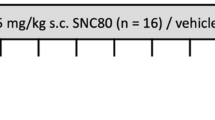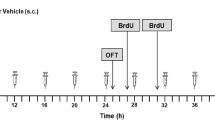Studies of hibernating Yakutianian long-tailed ground squirrels (n = 42) addressed the effects of blockade of opioid receptors with naloxone on behavior in an open field and a holeboard chamber in the autumn (during preparation for hibernation) and in the spring (on waking at the end of hibernation). The inhibitory effects of opioid receptor blockade on systematic parameters of the overall level of CNS activation of the squirrel CNS were more marked in the autumn than in the spring. Biochemical analysis of monoamine contents revealed differences in the noradrenaline/serotonin ratio in the animals’ brains in spring and autumn. It is suggested that the interaction between the opioid and monoaminergic systems, working with a number of other factors, transfers homeostasis in hibernating animals to the new levels required both for preparation for entering hibernation – in autumn – and for transfer to the active homeothermic state – in spring.
Similar content being viewed by others
References
Kh. Yu. Ismailova, T. M. Agaev, and T. P. Semenova, Individual Characteristics of Behavior, Nurlan, Baku (2007).
S. G. Kolaeva, “Winter hibernation,” Vestn. Rus. Akad. Nauk., 63, No. 12, 1076–1081 (1993).
V. S. Kurin, I. I. Miroshnichenko, and K. S. Raevskii, “Differences in the mechanisms of autoreceptor regulation of dopamine biosynthesis and release in subcortical structures in the rat brain,” Neirokhimiya, 7, No. 1, 3–8 (1988)
V. S. Kurin, P. M. Klodt, V. B. Narkevich, et al., “Behavioral and neurochemical aspects of the antidepressant actions of GSB-106 – a dipeptide fragment of brain-derived neurotrophic factor BDNF,” Eksperim. Klin. Farmakol., 75, 41–45 (2012).
A. N. Inozemtsev, L. F. Panchenko, S. V. Litvinova, et al., “Effects of fluoxetine on the interaction of the serotoninergic and endogenous opioid systems in the correction of cognitive functions and the formation of tolerance to the actions of morphine,” Narkologiya, 4, 14–21 (2008).
L. I. Murav’eva and A. Yu. Budantsev, “On the role of brain biogenic amines in regulating winter sleep,” Usp. Sovrem. Biol., 96, 117–124 (1983).
N. K. Popova, E. V. Naumenko, and V. G. Kolpakov, Serotonin and Behavior, Nauka, Novosibirsk (1978).
T. P. Semenova, “Characteristics of the monoaminergic regulation of higher nervous activity in hibernating animals (Citellus undulatus),” Zh. Vyssh. Nerv. Deyat., 54, No. 2, 174–182 (2004).
T. P. Semenova, I. A. Anoshkina, L. P. Dolgacheva, et al., “Seasonal characteristics of the monoaminergic regulation of behavior in hibernating animals,” Ros. Fiziol. Zh., 86, No. 9, 1188–1194 (2000).
A. Beckman and C. Llados-Eckman, “Antagonism of brain opioid peptides action reduces hibernation bout duration,” Brain Res., 328, No. 1, 201–205 (1985).
C. V. Borlongan, Y. Wang, and T. P. Su, “Delta opioid peptide (D-Ala 2, D-Leu 5) enkephalin: linking hibernation and neuroprotection,” Front. Biosci., 9, 3392–3398 (2004).
N. Bourhium, M. Kabine, and M. S. Elkebbaj, “Characterization of opioid peptides and opioid receptors in the brain of Jerboa (Jaculus orientalis), a hibernating rodent,” Brain Res. Bull., 44, No. 5, 615–620 (1997).
Y. Cui, T. F. Lee, and L. C. H. Wang, “State-dependent changes of brain endogenous opioids in mammalian hibernation,” Brain Res. Bull., 40, No. 2, 129–133 (1996).
Y. Cui, T. F. Lee, J. Westly, and L. C. H. Wang, “Autoradiographic determination of changes in opioid receptor binding in the limbic system in the Columbian ground squirrel at different hibernation states,” Brain Res., 747, No. 2, 189–194 (1997).
P. Devoto, G. Flore, L. Pira, et al., “Co-release of noradrenaline and dopamine in the prefrontal cortex after acute morphine and during morphine withdrawal,” Psychopharmacology (Berlin), 160, No. 2, 220–224 (2002)
G. D. Ellison and D. E. Bresler, “Tests of emotional behavior in rats following depletion of norepinephrine, of serotonin, or of both,” Psychopharmacologia (Berlin), 34, 275–288 (1974).
D. D. Feist and W. A. Galster, “Changes in hypothalamic catecholamines and serotonin during hibernation and arousal in the arctic ground squirrel,” Comp. Biochem. Physiol., 48, 653–662 (1974).
Y. Feng, X. He, Y. Yang, et al., “Current research on opioid receptor function,” Curr. Drug Targets, 13, No. 2, 230–246 (2012).
I. I. Haak, E. Mignot, T. S. Kilduff, et al., “Regional changes in central monoamine and metabolite levels during the hibernation cycle in the golden-mantled ground squirrel,” Brain Res., 563, 215–220 (1991).
S. J. Mansour, H. Khachaturian, M. E. Lewis, et al., “Anatomy of CNS opioid receptors,” Trends Neurosci., 11, No. 2, 308–314 (1988).
B. Michealidis, N. S. Loumbourdis, and E. Kapaki, “Analysis of monoamines? Adenosine and GABA in tissues of the land snail Helix lucorum and lizard Agama stellio during hibernation,” J. Exp. Biol., 205, No. 8, 1135–143 (2002).
A. R. McQuiston, “Opioid receptor activation normalizes temporo-ammonic pathway driven inhibition in hippocampal CA1,” Neuropharmacology, 60, No. 2–3, 472–479 (2011).
H. Montel, K. Starke, and H. D. Taube, “Infl uence of morphine and naloxone on the release of noradrenaline from cerebellar cortex slices,” Naunyn Schmiedebergs Arch. Pharmacol., 288, 427–433 (1975).
F. Nurnberger, “The neuroendocrine system in hibernating mammals: present knowledge and open questions,” Cell Tiss. Res., 28H, 391–412 (1995).
Z. Pirger, A. Lubitcs, D. Reglodi, et al., “Mass spectrometric analysis of activity-dependent changes of neuropeptide profile in the snail, Helix pomatia,” Neuropeptides, 44, No. 2, 475–483 (2010).
K. R. Powell and L. A. Dykstra, “The role of serotonergic receptors in the effects of mu opioids in squirrel monkeys responding under a titration procedure,” Psychopharmacology, 126, No. 1, 42–49 (1996).
T. P. Semenova, I. A. Anoshkina, B. H. Khomut, and S. G. Kolaeva, “Seasonal peculiarities of behavior of ground squirrels Citellus undulatus in the holeboard and open field tests,” Behav. Processes, 56, No. 1, 195–200 (2001).
K. B. Storey and J. M. Storey, “Metabolic rate depression in animals: transcriptional and translational controls,” Biol. Rev. Camb. Phil. Soc., 79, 207–233 (2004).
Y. Tamura, M. Shintani, H. Inoue, et al., “Regulatory mechanism of body temperature in the central nervous system during the maintenance phase of hibernation in Syrian hamsters: involvement of beta- endorphin,” Brain Res., 1448, No. 1, 63–70 (2012).
R. Tao and S. B. Auerback, “Opioid receptor subtypes differentially modulate serotonin efflux in the rat central nervous system,” J. Pharmacol. Exp. Ther., 303, No. 2, 1549–1556 (2002).
G. J. Wang, N. D. Volkow, J. S. Fowler, et al., “Dopamine D2 receptor availability in opiate-dependent subjects before and after naloxone-precipitated withdrawal,” Neuropsychopharmacology, 16, No. 2, 174–182 (1997).
L.-C. Lu and Y.-P. Cai, “Effects of opioid receptor antagonists administration to suprachiasmatic nucleus on hibernation of ground squirrels Citellus dauricus,” Comp. Biochem. Physiol., 104, No. 2, 249–252 (1993).
Author information
Authors and Affiliations
Corresponding author
Additional information
Translated from Rossiiskii Fiziologicheskii Zhurnal imeni I. M. Sechenova, Vol. 99, No. 11, pp. 1265–1272, November, 2013.
Rights and permissions
About this article
Cite this article
Semenova, T.P., Zakharova, N.M. Seasonal Features of the Effects of Blockade of Opioid Receptors on Adaptive Behavior in Hibernating Animals. Neurosci Behav Physi 45, 658–663 (2015). https://doi.org/10.1007/s11055-015-0125-5
Received:
Revised:
Published:
Issue Date:
DOI: https://doi.org/10.1007/s11055-015-0125-5




